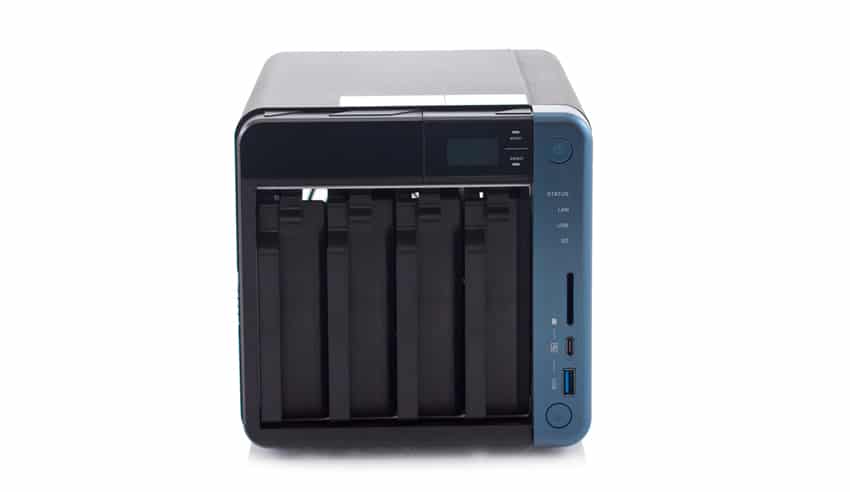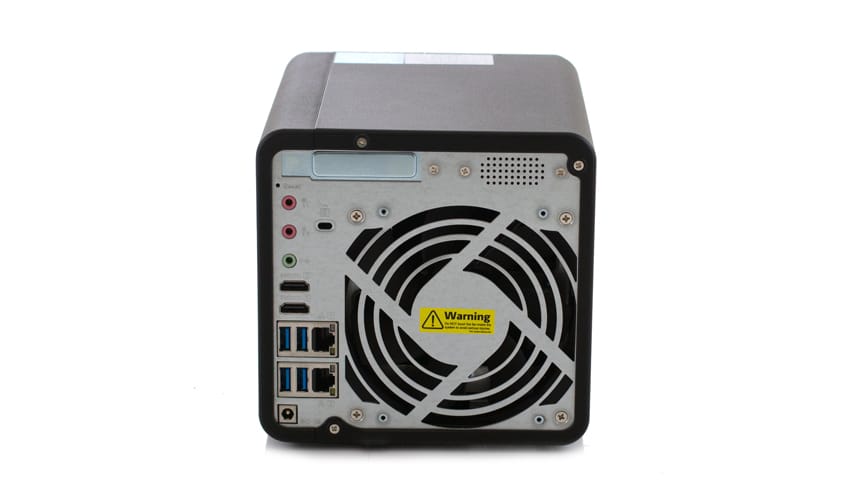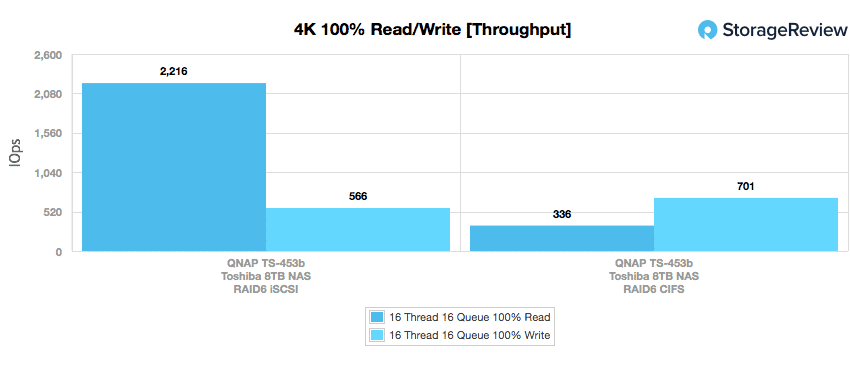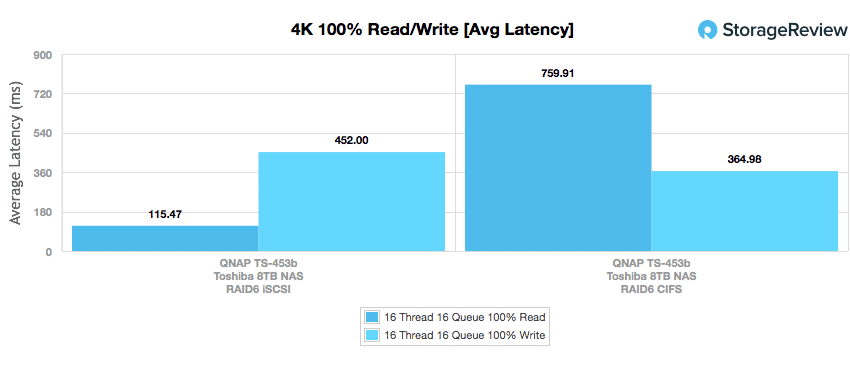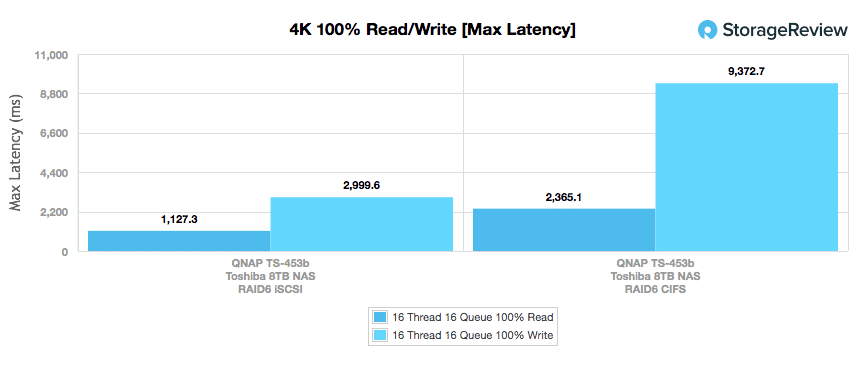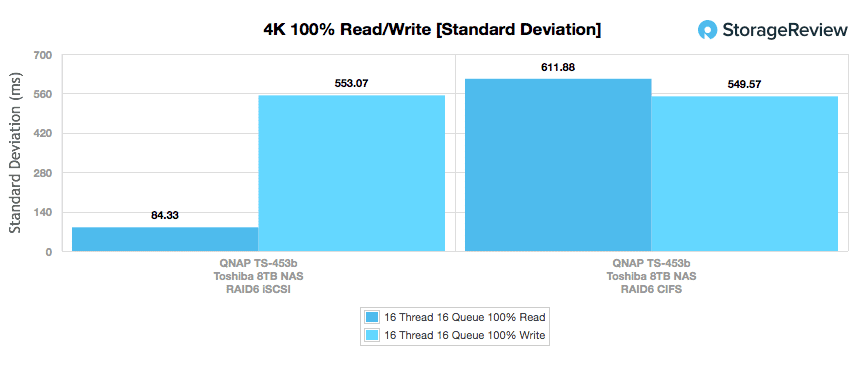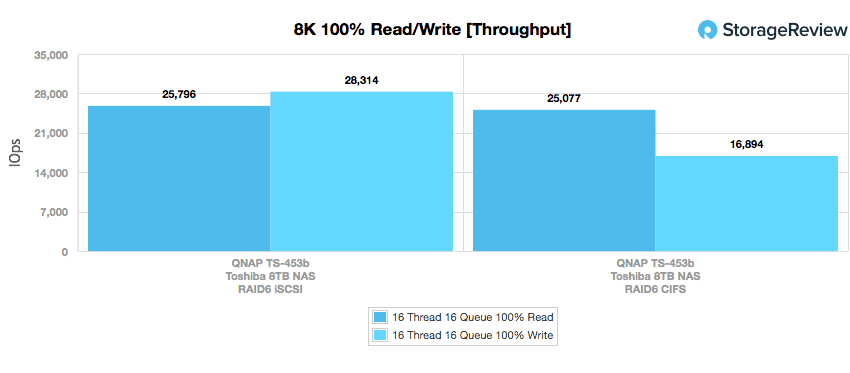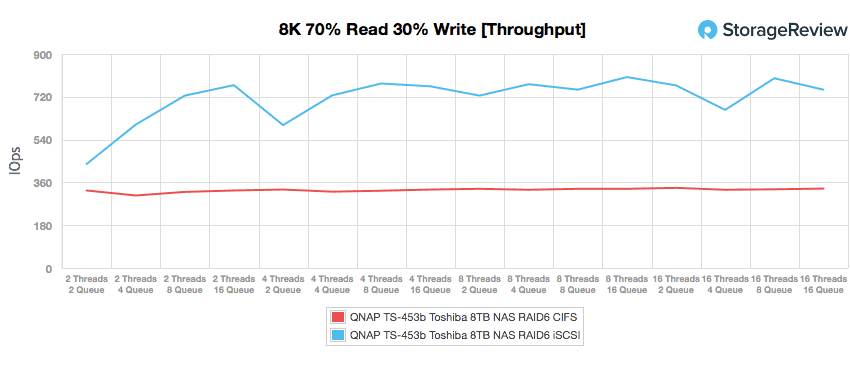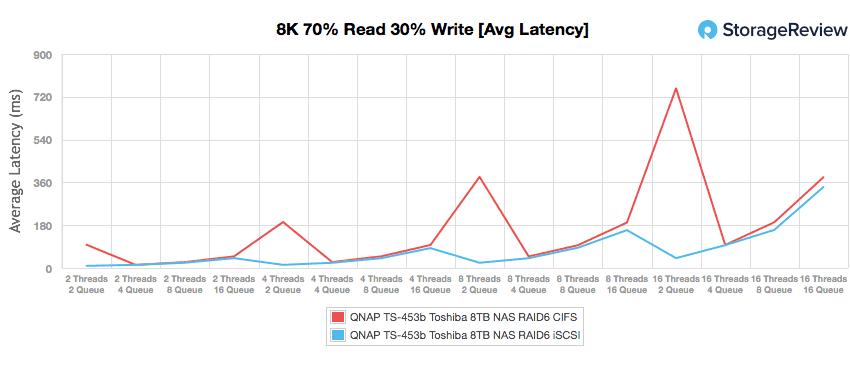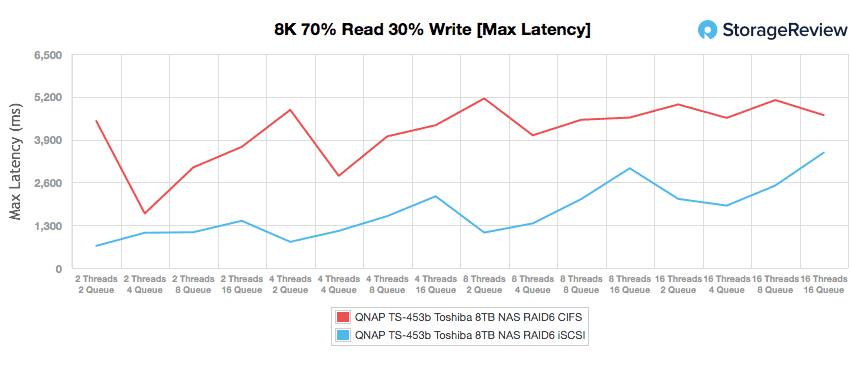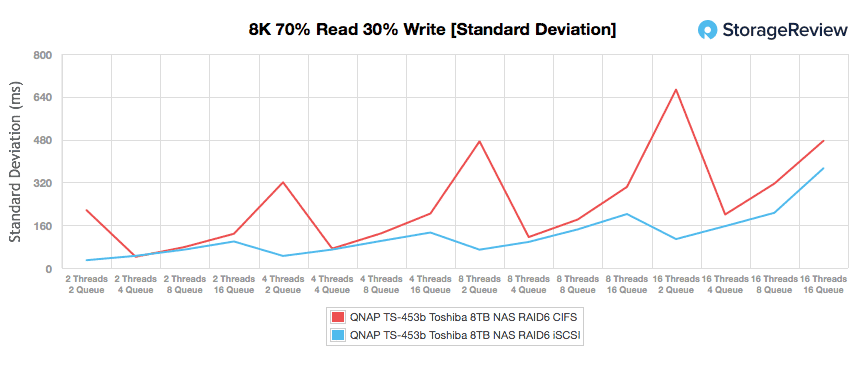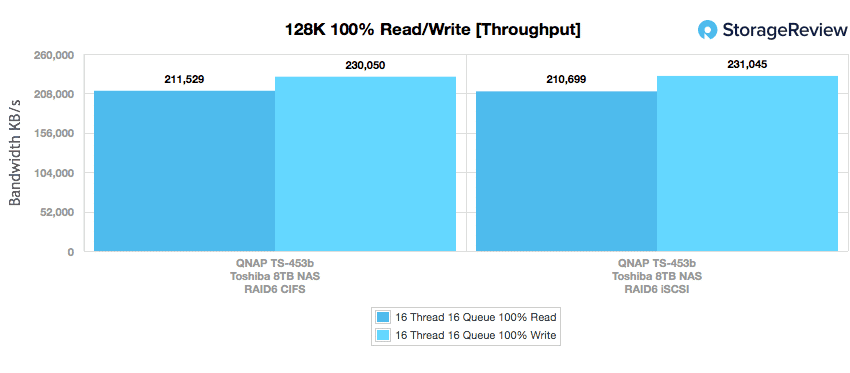
The TS-453B is the 4-bay model of QNAP’s completely redesigned line of versatile consumer and home business NAS devices. Powered by an Intel quad-core processor, the QNAP TS-453B is a QTS-Linux combo NAS that is well-suited for virtualization, centralized storage, backup, sharing, and disaster recovery. We previously reviewed the 2-bay TS-253B model, and found it to have a good mix of performance and capacity for SOHO and smaller businesses.
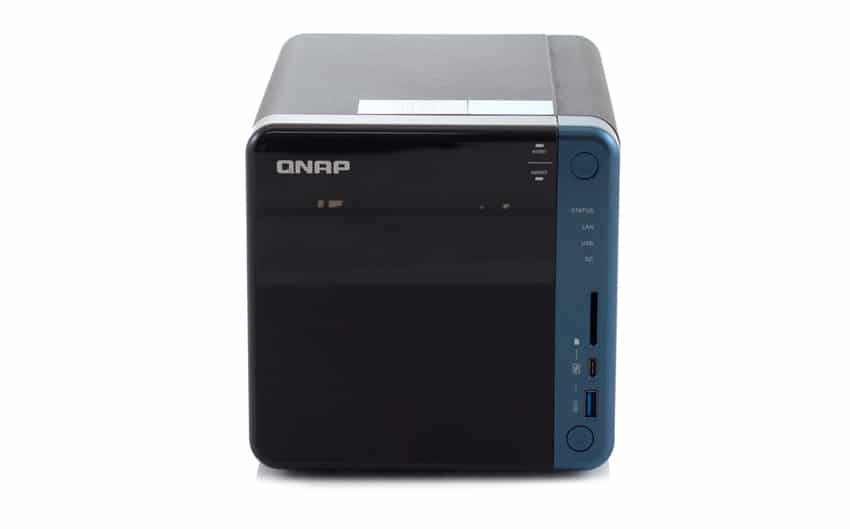
Equipped with a PCIe port, the TS-453B can tackle a range of different storage use cases, making it a very flexible NAS. For example, when outfitted with the QNAP QM2 expansion card, users can install an M.2 SSD for cache. A 10GbE networking card is another option. Users can also choose to install a compatible wireless card to turn the TS-453B into a wireless access point, or add a USB 3.1 10Gbps card for faster backup to and from external storage devices.
The TS-453B features a USB Type-C QuickAccess port and an SD card slot, which helps makes file transfers and sharing files quick and easy and without the need for a network connection. Like all QNAP NAS devices from this class, the TS-453B is also highlighted by its multimedia functionality, including 4K (30Hz) video playback and both real-time and offline transcoding.
With its Intel Celeron J3455 quad-core 1.5GHz CPU, (up to) 8GB DDR3L RAM, dual Gigabit LAN ports, and SATA 6Gb/s, the TS-453B is quoted to deliver upwards of 225MB/s for both read and write speeds. QNAP also claims that it can reach these speeds when using the Intel AES-NI hardware-accelerated encryption (AES 256-bit) for both full NAS volumes and shared folders, giving users a peace of mind that their data is safe and secure without having to sacrifice performance.
QNAP TS-453B Specifications
| CPU | Intel Celeron J3455 quad-core 1.5 GHz, up to 2.3 GHz |
| Encryption | Accleration (AES-NI) |
| Graphics | Intel HD Graphics 500 |
| System memory | (2 x 4GB) 8GB DDR3L |
| (2 x 2GB) 4GB DDR3L | |
| Maximum Memory | 8GB |
| Total Memory Slots | 2 x DDR3L SODIMM slots |
| Drive | Hot-swappable 4 x 3.5"/2.5" SATA 6Gb/s HDD/SSD |
| GbE LAN Port | 2 x RJ45 Gigabit LAN port |
| 10GbE LAN Port | Optional 10 Gigabit LAN port via a PCIe expansion card |
| USB 3.0 Port | 5 x USB 3.0 Type-A ports |
| USB QuickAccess | USB Type-C |
| PCIe Slot | 1 PCIe 2.0 x2 slot |
| HDMI Port | 2 x HDMI v1.4b, up to 3840 x 2160, 30 Hz |
| Audio Input | 2 x 3.5mm dynamic microphone input jacks |
| Audio Output | Speaker, 3.5mm line out jack |
| Display | 0.96” monochrome OLED |
| LED Indicators | Status/Power, LAN, USB, Drives, SD card, USB QuickAccess |
| Buttons | Power, USB copy, Reset, Capacitive touch buttons (select, enter) |
| Infrared Receiver | supplied with a QNAP RM-IR004 remote control (compatible with RM-IR002 remote control) |
| SDXC Card Reader | |
| Other Interfaces | Kensington security slot |
| Dimension (HxWxD) | 168 x 170 x 226 mm |
| 6.61 x 6.69 x 8.90 inch | |
| Weight Net | 2.37 kg |
| Weight Gross | 3.71 kg |
| Sound Level | Operating low speed: 18.8 dB |
| Operating Temperature | 0 ~ 40˚C (32˚F ~ 104˚F) |
| Relative Humidity | 5~95% RH non-condensing, wet bulb: 27˚C (80.6˚F) |
| Power Consumption | HDD sleep: 15.00W |
| Typical Operation: 30.04W | |
| Fan | 1 x 12 cm |
Design and build
Like the other models from the TS-x53B line, the TS-453B features a sleek a smooth plastic build highlighted by an aqua green panel. All models from this line have the same connectivity and functionality on this panel: power button, LEDs (status, drive and LAN), SD Card slot, USB QuickAccess port/LED (Type-C), USB 3.0 One Touch Copy port, and USB One Touch Copy button.
On the left side is the OLED panel with an enter and select button for navigation, allowing users to restart and power off, configure or change the OLED panel password, view and configure network settings, and to see information on the system, physical disks, and volumes of the TS-453B.
Turning the NAS around to the back panel reveals the 1 x 7cm system fan. To the left is the PCIe slot (with cover), 3.5 mm speaker and microphone jacks, 2 HDMI ports, a reset button, 4 USB 3.0 ports, 2 Gigabit RJ45 Ethernet ports, a Kensington security slot and a Power input port.
Enterprise Synthetic Workload Analysis
Our enterprise shared storage and hard drive benchmark process preconditions each drive into steady-state with the same workload the device will be tested with under a heavy load of 16 threads with an outstanding queue of 16 per thread, and then tested in set intervals in multiple thread/queue depth profiles to show performance under light and heavy usage. Since hard drives reach their rated performance level very quickly, we only graph out the main sections of each test.
Preconditioning and Primary Steady-State Tests:
- Throughput (Read+Write IOPS Aggregate)
- Average Latency (Read+Write Latency Averaged Together)
- Max Latency (Peak Read or Write Latency)
- Latency Standard Deviation (Read+Write Standard Deviation Averaged Together)
Our Enterprise Synthetic Workload Analysis includes four profiles based on real-world tasks. These profiles have been developed to make it easier to compare to our past benchmarks as well as widely-published values such as max 4k read and write speed and 8k 70/30, which is commonly used for enterprise drives.
- 4K
- 100% Read or 100% Write
- 100% 4K
- 8K 70/30
- 70% Read, 30% Write
- 100% 8K
- 8K (Sequential)
- 100% Read or 100% Write
- 100% 8K
- 128K (Sequential)
- 100% Read or 100% Write
- 100% 128K
In the first of our enterprise workloads, we measured a long sample of random 4K performance with 100% write and 100% read activity. In this scenario, the QNAP TS-453B posted its best read performance in iSCSI with 2,216 IOPS. When configured in CIFS, the TS-453B posted its best write activity with 701 IOPS.
In average latency, the TS-453B showed 452.003ms in writes and 115.475ms in reads, while CIFS measured 364.975ms and 759.912ms in writes and reads, respectively.
For max latency performance, the QNAP TS-453B recorded its best read and write performance in our iSCSI configuration with 1127.3ms and 2999.6ms, respectively
When looking at the standard deviation of random 4K performance, the TS-453B recorded 611.88ms read and 549.57ms write in CIFS, while reaching 84.329ms read and 553.07ms write under iSCSI.
Our next benchmark measures 100% 8K sequential throughput with a 16T/16Q load in 100% read and 100% write operations. The TS-453B recorded its best write performance by a significant margin under iSCSI with 28,314 IOPS (vs. 16,894 IOPS under CIFS); however, read speeds were almost identical.
Compared to the fixed 16 thread, 16 queue max workload we performed in the 100% 4K write test, our mixed workload profiles scale the performance across a wide range of thread/queue combinations. In these tests, we span workload intensity from 2 threads and 2 queue up to 16 threads and 16 queue. When looking at throughput, and the QNAP TS-453B iSCSI connectivity had the best performance with a range of 437 IOPS to 750 IOPS. CIFS managed to record an essentially static performance of 326 IOPS to 334 IOPS.
In average latency, iSCSI began at just 9.1ms but spiked in the higher queue depths with 340.53ms at 16T/16Q. Our CIFS configuration posted a range of 97.79ms to 381.9ms.
Looking at maximum latency showed a similar trend, as QNAP TS-453B showed solid burst performance when configured in iSCSI with 672.64ms and ended up with 3505.22ms.
In terms of standard deviation, the QNAP NAS recorded 29.18ms through 372.72ms under iSCSI and 216.06ms through 475.38ms under CIFS.
Our last test in our small NAS Synthetic Workload testing is the 128K test, which is a large block sequential test that shows the highest sequential transfer speed. When looking at the 128K performance of 100% write and 100% read activity, the TS-453B showed very similar performance in iSCSI and CIFS, with 211MB/s read and 231MB/s write, and 212MB/s and 230MB/s write, respectively.
Conclusion
Like the 2-bay model, the TS-453B is an impressive small business NAS from QNAP highlighted by its comprehensive NAS features for the Linux open-source platform. Powered by an Intel Celeron quad-core 1.5GHz CPU, 8GB of DDR3L RAM, and dual Gigabit LAN ports, this completely redesigned NAS line features good performance under Intel’s AES-NI hardware-accelerated encryption engine. The TS-453B also features an extremely useful PCIe slot, which adds a ton a versatility to the NAS.
The TS-453B also caters to the entertainment-centric consumer demographic as well, featuring a real-time and offline 4K transcoding, two HDMI ports, and two 13.5 mm speaker and microphone jacks. And, like all models from this line, it supports the one-way sync data to cloud storage via RTRR, Rsync, FTP, SMB protocol, as well as two-way sync NAS devices with remote NAS/cloud services including Amazon S3, Microsoft Azure and Dropbox.
Though the 4-bay model is virtually identical to the TS-253 as far as components go, it delivered slightly better performance overall. First, we measured 4K performance, which had its best read performance under iSCSI with 2,216 IOPS, while showing its best write performance under CIFS with 701 IOPS. Looking at 100% 8K sequential throughput, the TS-453B recorded its best read activity by far when with iSCSI connectivity (28,314 IOPS), though write speeds were virtually identical. In our large block sequential 128K test, the TS-453B posted similar performance across the board, with 211B/s read and 231MB/s write, and 212MB/s and 230MB/s write, respectively.
The Bottom Line
The newly designed TS-453B offers solid performance and will suit the needs of most small businesses. The 4-bay model also adds a bit extra versatility for those looking for a bit more storage than what a 2-bay model can provide.
Sign up for the StorageReview newsletter

